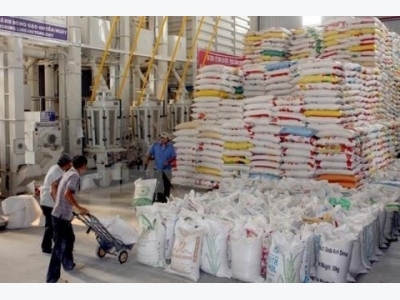VietGap standards to merit national rice brand

Rice products will be certified under the “Vietnam Rice” national brand if they are produced in accordance with VietGAP or GlobalGAP standards - good agricultural practices to produce clean and safe farm products.
Although Viet Nam annually exports five to seven million tonnes of rice per year, the amount of revenue the country earns is less than other countries already famous for their rice products such as Thailand and India.
This is one of the regulations drafted by the Ministry of Agriculture and Rural Development (MARD) to build, promote, manage and certify the national brand for Vietnamese rice exports.
The draft document, including seven chapters and 23 articles, has been circulated for experts’ opinions.
According to MARD, although Viet Nam annually exports five to seven million tonnes of rice per year, the amount of revenue the country earns is less than other countries already famous for their rice products such as Thailand and India.
Besides this, Vietnamese rice is also facing great competition from the rice brands of these countries. Thus, speeding up the promotion of the national rice brand is one of the urgent solutions to help increase the product’s added value, and subsequently export revenue.
Vo Thanh Do, deputy director of MARD’s Agri-product Processing and Market Development Department, said building a national brand for Vietnamese rice (Vietnam Rice) will promote the image of products and create trust among consumers.
As a result, the competitiveness of Viet Nam’s rice products in the world market will be enhanced, Do said.
Do said the regulation aims to ensure rice products have stable characteristics and meet requirements in terms of quality and origin traceability.
However, it also raised concerns among agricultural experts and business insiders.
According to Nguyen Anh Tuan from the Northern Food Corporation, the application of VietGap standards in rice cultivation is important and should be encouraged.
However, the reality is that the area where rice is cultivated according to VietG standards is not large, Tuan said.
Sharing the view, Nguyen Duc Cuong, a representative from the Tuong Lan Agricultural Products Processing Company, said many regions in Viet Nam have few rice production areas meeting the VietGap standard due to the scattered production situation.
Therefore, rice enterprises would find it hard to meet requirements, Cuong added.
Do acknowledged that a company producing 400,000 tonnes of rice would need some 80,000ha of raw material, adding that if the annual export volume is taken into account, the areas meeting VietGAP standard are not enough.
Tran Xuan Dinh, deputy head of MARD’s Cultivation Department, said the Vietnamese rice national brand should not be granted to rice products satisfying VietGAP. It should instead be granted to those meeting Good Agricultural Practices (GAP) in general.
Dinh explained that in many rice growing regions, land and water indicators are within acceptable limits for the application of GAP techniques.
In addition, standards for safe agricultural products TCVN: 11892/12017 may be applied to replace and evaluate the quality of Vietnamese rice, he said.
Rice types
According to the draft regulations, the types of rice bearing the national brand certification must be white rice, white fragrant rice and white glutinous rice grown in areas planned by the State and meet the quality requirements as regulated.
However, Phan Van Hoa, director of the Vinh Hoa Science and Technology Co Ltd, said the current rice varieties of Viet Nam, even glutinous rice and aromatic rice, are in different colours, so the above regulation will reduce the amount of qualified products.
With regard to this issue, Do said the country currently does not have many varieties of coloured rice, and this regulation only aims at rice products for export under the Government scheme, therefore it should focus on three groups of rice.
Do said the Agri-product Processing and Market Development Department is assigned by MARD to register the ownership of the “Gao Viet Nam/Vietnam Rice” national brand at the Intellectual Property Department.
The draft regulations on building, promoting, managing and certifying the national brand for Vietnamese rice exports are expected to be finalised this month.
Rice is among the products that have witnessed high growth rate in recent years. The volume of rice exported in November is estimated at 389,000 tonnes, worth US$192 million.
The figures for 11 months of the year was 5.49 million tonnes and $2.48 billion, respectively, representing an increase of 23.4 per cent in terms of volume and 24.2 per cent in value over the same period in 2016.
China continues to rank first in the rice import market of Viet Nam in the first 10 months of 2017 with 39.8 per cent of the market share.
Có thể bạn quan tâm
Phần mềm

Phối trộn thức ăn chăn nuôi

Pha dung dịch thủy canh

Định mức cho tôm ăn

Phối trộn phân bón NPK

Xác định tỷ lệ tôm sống

Chuyển đổi đơn vị phân bón

Xác định công suất sục khí

Chuyển đổi đơn vị tôm

Tính diện tích nhà kính

Tính thể tích ao hồ



 Rice export: Success exceeds expectations
Rice export: Success exceeds expectations  High-tech farming model helps farmers escape poverty
High-tech farming model helps farmers escape poverty